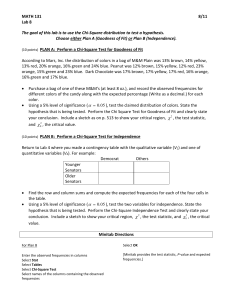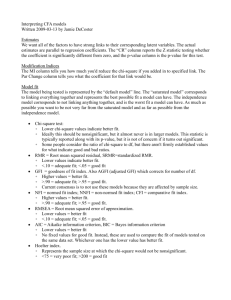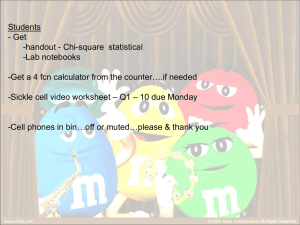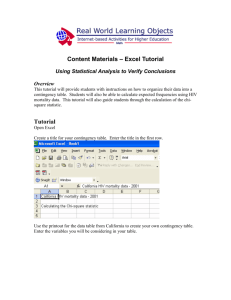18 I study unit eighteen the chi-square test
advertisement
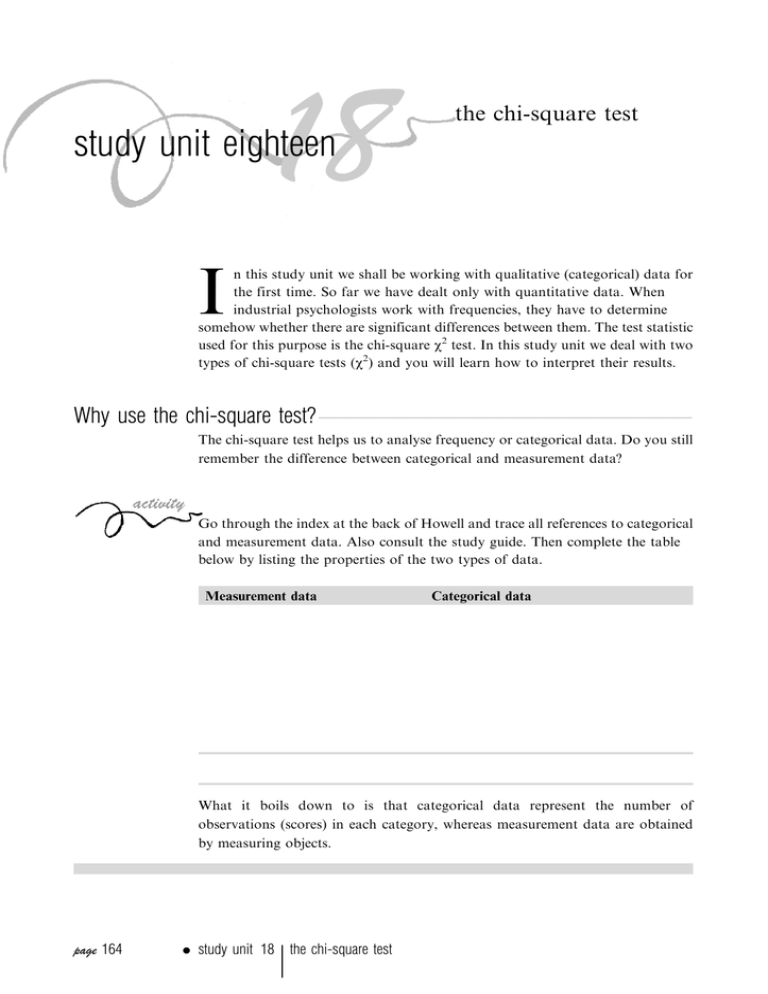
18 study unit eighteen the chi-square test I n this study unit we shall be working with qualitative (categorical) data for the first time. So far we have dealt only with quantitative data. When industrial psychologists work with frequencies, they have to determine somehow whether there are significant differences between them. The test statistic used for this purpose is the chi-square X2 test. In this study unit we deal with two types of chi-square tests (X2) and you will learn how to interpret their results. Why use the chi-square test? ________________________________ The chi-square test helps us to analyse frequency or categorical data. Do you still remember the difference between categorical and measurement data? Go through the index at the back of Howell and trace all references to categorical and measurement data. Also consult the study guide. Then complete the table below by listing the properties of the two types of data. Measurement data Categorical data What it boils down to is that categorical data represent the number of observations (scores) in each category, whereas measurement data are obtained by measuring objects. page 164 . study unit 18 the chi-square test . section 3 data processing: inferential What types of chi-square tests are there? _______________________ By way of orientation, look at the inside of the cover of Howell and follow the tree diagram for qualitative data. You will see that we can only work with two categorical variables and that we can use only two types of chi-square tests: goodness-of-fit and contingency tables. Howell explains the reason for using the chi-square test in his introduction to chapter 19. . Go through the introduction to chapter 19 in Howell and make sure that you see the need for using this type of statistic. The difference between the two types of chi-square tests that we shall be using Ð one- and two-classification variables Ð is explained with reference to simple examples. . Summarise the difference between a one-classification and a two-classification variable in the table below: One-classification variable Two-classification variable Now that you know the difference between the two types of variables we shall explain how to compute them. When to use the one-classification variable: the chi-square goodness-of-fit test __________________________________________________ When we are working with only one variable we use the goodness-of-fit test. That is the name of this particular type of chi-square test. Here the assumption is that we compare only one set of observed data with a theoretical prediction of frequencies, that is, we are working with observed (O) and expected (E) scores. At this stage we are introduced to certain formulas and symbols. To familiarise yourself with them, study section 19.1 in Howell. . Learn the symbols of the formulas and how to compute them. . Check the computations with your pocket calculator. . Make sure that you can read the value off table E.1 correctly. . Then follow the steps that Howell describes under the heading ``The Chi-square distribution'', on page 375. page 165 Does the process seem familiar? It should, since it is the same procedure that is followed in all hypothesis testing (eg when computing the t- and F-tests). The only difference is that the data look different, which is why we use a different test statistic Ð in this case the chi-square test. What happens when we work with more than two categories? _________ It is possible to classify data in more than two categories. This is simply an extension of what we were doing above. Here is an example of data in more than two categories. Work through ``Extension to the multicategory case'' on page 377 in Howell. You have to be able to compute it, so follow the steps and check the computations with your pocket calculator. When you have finished, do the following exercise: Write the formulas for both types of data and summarise the difference between them in your own words: _______________________________________________________________________________________________________________________________ _______________________________________________________________________________________________________________________________ _______________________________________________________________________________________________________________________________ _______________________________________________________________________________________________________________________________ _______________________________________________________________________________________________________________________________ The formulas look identical; so do the computations. The only difference is that in the case of more than two categories your summation covers more categories Ð all of them, in fact. By now you have come across a lot of new concepts. Let us first summarise what you have done up to now. You should be able to . know when to perform the chi-square test . compute the chi-square test (goodness-of-fit) for two or more categories . interpret the results on the basis of rejection or nonrejection of the null hypothesis Now attempt the following exercises to evaluate your proficiency in applying the chi-square test. Exercises 19.5 and 19.1 (Yes, in that order Ð 19.5 is simpler for a first attempt!) Remember to follow all the steps that you learned in study unit 13. So you should page 166 . study unit 18 the chi-square test . section 3 data processing: inferential start by formulating a null hypothesis, then ... (Do you still remember all the steps?). Compare your answers with the ones in the Student handbook. When to use the two-classification variables: contingency table chi-square _____________________________________________ Often the data we are using cannot be classified as a single variable. Sometimes the data fall into two categories, and the variable (data) is classified as two variables. In such cases we speak of a contingency table. Here we have another new concept. Howell explains it very simply. Work through section 19.2 for a clear grasp of the concept. . Use your pocket calculator to check the computations. Write your own definition of a contingency table: _______________________________________________________________________________________________________________________________ _______________________________________________________________________________________________________________________________ _______________________________________________________________________________________________________________________________ Did your definition include the following? We work with a classification in which the observation is classified in respect of two variables simultaneously. 1 Read section 19.3 on ``Correction for continuity'' attentively. 2 Study section 19.4 in Howell. . Use your pocket calculator to check the computations. page 167 You have learnt quite a lot of new things regarding contingency tables. Having learnt these concepts and skills, you should now be able to . explain what a contingency table is . know when to use a contingency table . compute the chi-square test for two classification variables . interpret the result on the basis of rejection or nonrejection of the null hypothesis Now try to do the following exercise to evaluate your proficiency at applying the chi-square test. 1 A television company wants to find out whether there is a difference between men and women in their preference for viewing times of favourite television programmes. A group of 300 persons are randomly selected to complete a questionnaire. They are asked to choose only one of the three times indicated as their preference. The three times are indicated as late afternoon (16:00 ± 18:00), early evening (18:00 ± 20:00) and late evening (20:00 ± 22:00). Of the female respondents, 60 indicate late afternoon as their preferred time, 40 early evening and 50 late evening. Among the male respondents 60 indicate late evening as their preferred time, while 50 indicate early evening and 40 indicate late afternoon. In order to schedule their programming optimally, the television company needs to know whether males and females differ significantly in their preference of viewing times of favourite programmes. 1.1 Make a contingency table to represent the given information. 1.2 Do the necessary calculations to determine if there is a significant difference between the preferences of the two genders in their choice of preferred viewing time. 1.3 Work on a significance level of 0,05. What is your deduction? (Refer to the research question.) 2 Also do exercise 19.11 in Howell. 1.1 Men Women Total 16:0018:00 40 (50) 60 (50) 100 18:0020:00 50 (45) 40 (45) 90 20:0022:00 60 (55) 50 (55) 110 Total 150 150 300 The number in parentheses are the expected frequencies, computed according to the formula: Eij = page 168 . study unit 18 Ri Cj N the chi-square test . section 3 data processing: inferential For our question: E11 = 150 100 300 50 E12 = 150 90 300 45 E13 = 150 110 300 55 E21 = 150 100 300 50 E22 = 150 90 300 45 E23 = 150 110 300 55 2 1.2 2 O ÿE E = 40 ÿ 502 50 = ÿ102 50 102 50 60 ÿ 502 50 52 45 50 ÿ 452 45 ÿ52 45 52 55 40 ÿ 452 45 60 ÿ 552 55 50 ÿ 552 55 ÿ52 55 = 2 2 0; 56 0; 56 0; 45 0; 45 = 6; 02 1.3 a = 0; 05 df = (R 7 1) (C 7 1) = (2 7 1) (3 7 1) = 2 2calc = 6; 02 2crit 5; 99 6,02>5,99 2 ; Reject H0 ; There is significant difference between men and women with regard to their preferred viewing times of favourite programmes. Compare your answer with the one in the Student handbook. Do small frequencies play a role?_____________________________ Yes, small frequencies do play a role. Even when they are small, they influence a test. Sometimes frequencies are expressed as proportions, but usually they are converted back into frequencies. It is also possible to make nonindependent observations. Read section 19.5 in Howell attentively. Work through section 19.8 and make sure that you can identify the X2-value on the printouts. page 169 Data set exercise: Appendix D (Appenc.dta) The output of exercise (appenc.dta) looks like this: page 170 . study unit 18 the chi-square test . section 3 19 study unit nineteen data processing: inferential multivariate statistical techniques T he statistical techniques that you have learnt so far will enable you to understand a lot of research reports and articles, but you will also come across many studies involving multivariate statistical techniques (descriptive and inferential). You will only study these techniques at postgraduate level in Industrial Psychology, but we introduce you to them here so that you are not completely ignorant about them. Definition of multivariate statistics ____________________________ Multivariate statistics are all statistical techniques that analyse multiple (more than two) measurements of each individual or object simultaneously. These techniques are actually just extensions of the following: . univariate distributions, such as Ð mean Ð variance and standard deviation Ð t-tests (related and independent) Ð one-way ANOVA (one dependent variable) and . bivariate analyses, such as Ð correlation Ð regression (simple regression with one independent variable) The purpose of multivariate statistical analysis is to measure, explain and predict relations between variates (weighted combinations of variables). Every type of multivariate statistical technique requires a special measurement scale. Do you still remember the names of the four kinds of measurement scales? (We dealt with them in study unit 4.) Ranked from the simplest to the most complex in terms of their characteristics, the four scales are . . . . nominal ordinal interval ratio page 171

